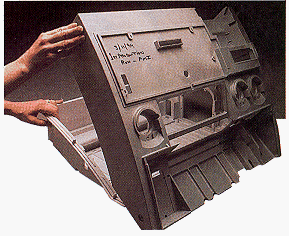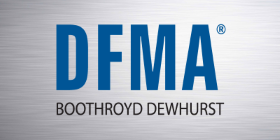|
DFMA Slashes Costs of Blood Analyzers DFMA software from Boothroyd Dewhurst lets designers produce a significantly improved case molding for Ciba Corning's 800 Series blood-gas analyzer. The outer shells hinge together like a suitcase, making assembly easier and faster, with a closer fit than the previous 200 Series analyzer. When Ciba Corning Diagnostics Corp. set out to upgrade its line of blood-gas analyzers, it established aggressive cost and high-quality targets. The new family of analyzers had to share a single base platform that could be upgraded at the customer's site to change with clinical demands. The analyzers also had to be durable, easy to assemble, and simple to use. Design for Manufacture and Assembly (DFMA) software, developed by Boothroyd Dewhurst Inc., Wakefield, R.I., was selected to help cut costs and part count. Says David Yeo, new product manufacturing engineer at Ciba Corning, "Each design engineer was teamed with a manufacturing engineer throughout the project to focus on manufacturing and assembly methods. We set up an area where those who had input on the design could work together." All assemblies were run through the DFMA analysis which provided estimates for assembly costs. But more importantly, the analysis prompted discussions about material selection and part fit. Some of the most significant changes made to the new model were in the hydraulic system in the upper caseworks. For example, the reagent manifold was made from a solid block of acrylic, eliminating need for numerous tubes. It reduced hydraulics parts content by 80%. The upper caseworks presented a particular challenge. From the solid-model geometry, stereolithography was used to develop the first model, followed by rubber and cast urethane, and finally structural foam. "DFMA reduced total parts count, but the product still had to be highly functional with numerous features. Packing more functions into a single component presented a challenge to conventional prototyping methods. Three-dimensional solid modeling and stereolithography for rapid prototyping were able to meet that challenge," said Yeo. DFMA analysis helped reduce the overall number of parts by 48%, fluidic connections by 60%, and the cost by 22%. The designers also found trade-offs in molding snap fits and holes for screws or Tinnerman fasteners that helped reduce cost. The difference between the old 200 Series and the new 800 Series is dramatic. The new model contains fewer components, most of which are self-aligning. "We paid special attention to self-locating features. We didn't want to reorient any part more than we needed. Now, when assembling the 800 Series, the pins match up to specific holes and parts fit mating parts," says Yeo. One example of how the company might use DFMA software on upcoming projects relates to machining. According to Yeo, a machining software module would have helped even more in deciding if it was economical to produce separate parts. He will look closely at future DFM shape-forming modules for this reason. Reprinted with permission from the 10/14/96 issue of
Machine Design |
|





